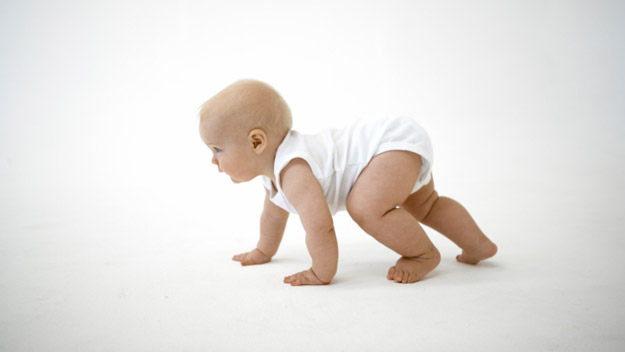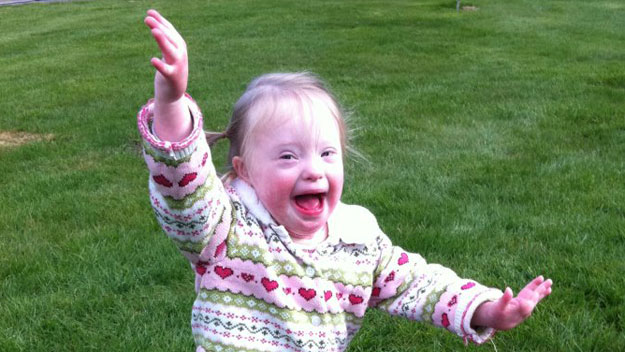When your baby is born she has no conscious control over her body, although she has natural reflex movements such as turning her head to your breast or gripping your finger. She will soon master control, starting from the head downwards – and over the next 12 months the speed at which she gains control of her body is incredible.
Here we’ve given a rough guide to what might happen when, but remember that babies’ developmental rates vary enormously. If you have any worries, talk to your baby health nurse or GP.
Newborn
Your newborn will tend to lie in a scrunched-up position. She has little control over her arms and legs, and her hands will be tightly fisted. She can’t control her head, apart from being able to turn it from side to side when lying down. However, by around two weeks, hold her against your shoulder and you might notice little woodpecker movements – that’s your baby trying to hold her head up.
One month
Your baby is spending an increasing amount of time kicking now. She moves her arms too, and this means she’ll eventually bring them down to rest at her sides instead of holding them in the air. By around six weeks she’s discovered her hands – though she doesn’t yet know they belong to her! And by the end of the month she’s also opening up those little fists more and more, and may even make her first vague swipes at objects.
Two months
Your baby’s control of her body is growing at an incredible rate. By eight weeks, she is increasingly able to hold her head up but still needs support. By nine or 10 weeks she may have learnt how to roll from her side to her back.
Three months
The stronger muscles in her back and neck mean she now has good head control and you’ll only need to support her head if you hold her in an unusual position such as when bending over. This control means she can now turn her head to follow an object and even lift it for a few seconds when she’s lying on her back before she flops it down again – this is the beginning of trying to sit up. If you carefully prop her up with some cushions she’ll be able to keep her back straight. She may now also be able to roll from back to side.
Four months
Hold her in a standing position on your lap, and she may take at least a little of her own weight by pushing down with her toes as she practices strengthening her knees. Within the next couple of months her strength and control grows until she enjoys bouncing with both feet. She’s testing and strengthening her knees in preparation for crawling and walking later on. Rolling from front to back may also start at around four months – rolling from back to front is more complicated and more muscle building is needed to achieve it.
Five months
By five or six months, if you pull her up to sitting she may actually have the strength to support herself. Don’t let go of her, though – she probably won’t yet have the balance to keep herself there! She may need propping up with pillows, or may use her hands to make a tripod for balance.
Six months
At six months your baby may be able to push up with both hands, lifting her head and shoulders off the ground if playing on her front. She might also pull her knees under her and push her tummy up – it may look like she’s trying to crawl, but it’s unlikely she’ll succeed. At six months your baby may have the strength to sit, but probably lacks the balance. She may also now start rolling to get around the floor – some babies find this such an effective way of moving that they give crawling a miss. Her legs are also strengthening in preparation for walking and crawling and she may really bounce up and down if held standing on your lap.
Seven months
From seven months to a year your baby develops righting reflexes which help balance develop – this means she may now be able to sit unsupported, although she will probably use her hands for balance.
Your baby’s increasing strength also means that when you support her in a standing position she may swap the bouncing movement she was making earlier in favour of moving from leg to leg – this enables her to test and strengthen her muscles. Independent standing, however, is still some way off.
Eight months
This month or next month, your baby will really start to enjoy sitting up and this opens a whole new world to her – she’s got a better view of things and can reach further for toys. Sitting may now become her favourite position, although she’ll still need help to get into this position for another month or so and will probably still support herself with her hands. She also may begin to crawl.
Nine months
Babies discover the fun of crawling around now. While her first attempts may be clumsy, or even propel her backwards (her arms may still be stronger than her legs), she’ll rapidly pick up speed. This skill is one of the more complicated milestones your baby will reach in her first year. First she has to learn to bear weight on her arms so she can push her stomach off the ground, then she has to straighten her arms and co-ordinate her legs at the same time, then she is able to move.
Don’t necessarily expect her to be an orthodox crawler, moving around on hands and knees. Some babies prefer to ‘commando’ crawl on their tummies, while other methods include bottom shuffling or bear walking – moving with straight arms and legs. Around 10 percent of babies never get around to crawling, but go straight to walking – this often happens if they’ve found a method of moving, such as rolling, that they find effective.
10 months
Your baby’s body control is still moving from the head downwards, and by around 10 months she is able begin to control her knees and feet. She can now stand – but not alone, as she still can’t balance. She may soon be able to pull herself into a standing position holding onto something – but she’ll find it much harder to get down again, and will at first plop down without control before learning that her bottom needs to stick out for a more controlled landing. Your baby is also making progress towards walking – hold her on your lap and she’ll try to walk forward as well as trample up and down on the same spot. She may also enjoy being walked along the floor by you holding both her hands.
11 months
Once your baby is standing, she may begin to cruise (walking sideways holding onto furniture for support). Later this will mature into the wide-legged stagger babies use when walking.
Child psychologist and author, Penelope Leach, has discovered there are different stages to cruising. A new cruiser uses both hands to hold on and keeps her body close to her support. Later she will stand a bit further back, use one hand and then let go. She may now also develop an interest in climbing – whether it’s upstairs or onto the sofa. She may also be able to walk along holding your hands – walking unaided is more likely to happen by 15 months. She may also enjoy being walked along with you holding both her hands and may also be able to sit down after standing up.
12 months
Your baby might take her first step around now, though the age at which children learn to walk varies enormously. It could be as early as nine months, although many babies wait until up to 17 months or even longer. As your baby starts to walk you’ll notice she doesn’t move in the same way as an adult – she maintains her balance at first by placing her feet wide apart and holding her arms high. She’ll probably lose balance a lot to start with and plop down on her bottom every few steps!

